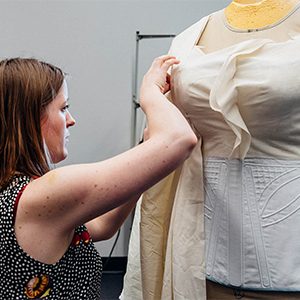A key figure in the Boston Expressionism movement—with art marked by the use of bold brushwork, dark satire, and, often, spiritual themes—David Aronson created sculptures, paintings, and drawings that reflected his complicated relationship with religion. These works include six-foot charcoal and pastel drawings and an almost eight-foot bronze door.
“It would have been easier to go ahead and make smaller works,” says his longtime art dealer, Bernie Pucker, “but rather than giving in to his facility, David always challenged himself.”
Aronson, a professor emeritus of art who taught at the College of Fine Arts for more than 30 years and developed the School of Visual Arts, died on July 2, 2015. He was 91.
In 1955, Aronson became the first chair of Boston University’s new Division of Art, today known as the School of Visual Arts. BU’s visual arts program launched during a national change in education for professional artists, when studio programs within university settings were increasing in popularity over traditional art schools and private studio classes. Aronson undertook the task of building a strong visual arts core curriculum alongside BU’s existing liberal arts course requirements that would prepare students before they chose an area of specialization.
The curriculum Aronson created with the help of the prestigious faculty he recruited—which boasted distinguished artists such as late professors emeritus Conger Metcalf, Joseph Ablow, and Jack Kramer—emphasized drawing, requiring students to take six to nine hours of drawing classes a week for the duration of their time at BU. “David’s vision of an art school has shaped much of the foundation program still in existence today,” says Lynne Allen, CFA dean ad interim. During his tenure as chair, Aronson also established the Boston University Art Gallery at 855 Commonwealth Ave.
Aronson resigned from his position as chair of the School of Visual Arts in 1963 to focus on teaching senior- and graduate-level painting courses, which he taught until he retired in 1989. He continued to build the program, and even recruited painter Philip Guston to teach a monthly seminar at the University.
Aronson forged his career on his own terms. His Orthodox Jewish father, a rabbi, had wanted him to follow in his footsteps, but Aronson pursued his own artistic passions and enrolled in the School of the Museum of Fine Arts, where he studied painting under Karl Zerbe, a leader of the Boston Expressionist movement, and eventually taught. There, he met his wife, Georgianna, who had been his student. Their son, Ben Aronson (CFA’80,’82) is also a painter, based in Framingham, Mass.
His work garnered national accolades. In 1946, when Aronson was just 22, the Museum of Modern Art selected him as one of the artists for its “Fourteen Americans” exhibition. Aronson was the youngest in the small group that included noted artists Saul Steinberg and Robert Motherwell.
He incorporated New Testament themes into his early work, an especially daring act, as he grew up in a strictly Orthodox Jewish household. Angels were a prevalent motif, says Pucker, adding that the “introduction of angels was very much against Jewish tradition.” Aronson was “questioning issues of what is holy and what is profane. He himself was wrestling with those angels. That, I think, would be a perfect way of understanding his work.”
The prolific artist won many awards for his paintings, sculptures, and drawings, including a 1960 Guggenheim fellowship. He continued to challenge himself by not only experimenting with massive scale, but also by changing his mediums, from charcoal to pencil to oil paint to the more esoteric medium of encaustic (hot pigmented wax).
His eight-foot bronze door aptly titled The Door, a triptych of intricate panels made between 1963 and 1969, is on display at the Museum of Fine Arts in Boston. This work is another example of how Aronson challenged himself, says Pucker. “It’s just a phenomenal work for a contemporary artist. He was not someone who had an entire studio. He did not have 20 apprentices helping him. There’s a built-in restraint to being a virtuoso, and he showed it in this piece.”
Aronson never considered a work of art finished, says Pucker. “David’s is a very carefully, thoughtfully created body of work. It was only because of catalogue deadlines that we got the work away from him. I admired that.”
















































I am the student pictured with David Aronson. He was a wonderful, kind person and a great teacher.